Pruning strawberries in summer after harvest: caring for garden strawberries after fruiting in July and August - feeding and processing
To have a good harvest of garden strawberries next season, you need to lay the foundation for it this year. In particular, it is important to carry out a number of measures for caring for strawberries after their fruiting and harvesting, in particular, to properly cut strawberry bushes.
Next, you will learn how to properly trim strawberries in the summer, as well as what else you need to do in July and August.

Content
Care of strawberries after fruiting and harvesting in July: main activities
After fruiting and harvesting, in mid-summer (July), strawberries need proper care.
Perhaps the most important thing at this time, to which, in fact, this material is devoted, is to prune strawberry bushes after they bear fruit.
Positive experience shows that after the summer pruning of strawberries has been completed, optimally good weed the beds and loosen the soil... Moreover, it is necessary to loosen near the bushes shallowly so as not to touch the root system, which is located very close to the surface. Then water it abundantly, and then do a light nitrogen fertilization. A little later (you can feed it in a day or two, or it can be closer to autumn), feed it with potash and phosphorus fertilizers, and then treat the bushes from diseases and pests (or do this at the end of summer).

Thus, the algorithm of actions when caring for strawberries in summer, after harvesting, consists of the following stages:
- trim leaves, peduncles and whiskers;
- weed and loosen the soil;
- water abundantly;
- feed with nitrogen, and a little later with potassium and phosphorus (or immediately after pruning with complex mineral fertilizer);
- perform treatment for diseases and pests (you can immediately after pruning, or a little later - in August).
By the way! To avoid tedious weeding and loosening every year, simply mulch the strawberries or plant them under a black film. Read how to do this. in this article.
Video: caring for strawberries after harvest: pruning, removing whiskers, weeding and loosening, feeding
Terms and rules for pruning strawberries after harvest
When to trim
After fruiting is completely over and you have collected the entire crop, it is recommended to cut off some of the strawberry leaves, its flower stalks and the resulting rosette mustache.
As for the approximate dates, then, as a rule, this falls on the second half of July.
How to prune properly: which leaves to remove and which to leave
Recommendation! Strawberry pruning is recommended exclusively with gardening gloves and only with the help of acute scissors or secateurs. Only no need to cut off leaves and mustache handsbecause they are strong enough and sit strongly in the ground, and you simply you can pull out part of the bush.
First of all, it is recommended to cut all lower leavesthat lie on the ground, no matter if they are healthy or sick.
Further, already look at the state of the bush: if the upper tier has leaves with signs of disease (in a dot or speck, all spotted), old and withered, then they are also needed trim, a healthy and young - leave.
Most often, strawberries, namely its leaf apparatus, are affected white or brown spot.
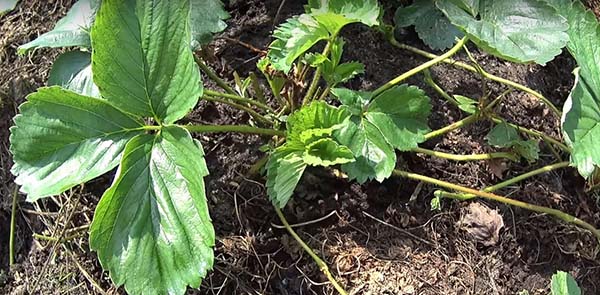
By the way! Do not forget to remove and fertile peduncles.
Video: pruning strawberries after fruiting
It would be quite logical to note that due to such pruning, the strawberry bush will get rid of some of the spores of pathogens and pests, and it will also be better ventilated and will not sour during the autumn rains.
Advice! All trimmed strawberry leaves are best burn (or take out of the site) in order to avoid the spread of various diseases, especially if they are with clear signs of disease and the presence of pests.
And their leaves are by no means cannot be composted!

There is a lot of controversy about whether it is possible to remove all strawberry leaves after fruiting, because this is the easiest way to do this.
Worth knowing! The fact is that if you cut the entire bush completely, then it will quickly deplete and strawberries will spend all their energy on restoring green mass instead of laying flower (fruit) buds for the next year and storing nutrients before wintering.
However, you must understand that in any case you will have to remove part of the green mass, which means that in the future you will help the plant to recover, that is, to feed it - to give the whole complex of macro- and microelements.
Note! But garden strawberries, which are very much affected by diseases and pests, it makes sense to completely remove in order to start a new strawberry plantation next year.
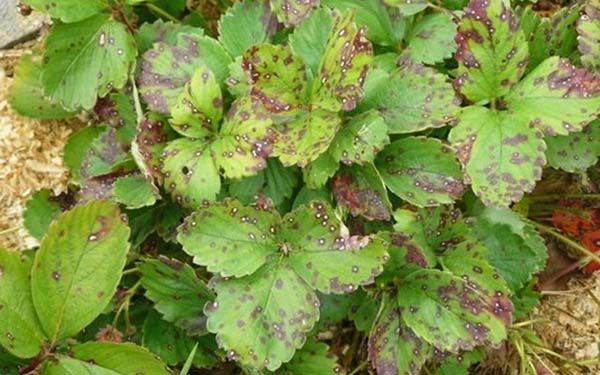
However, if you really feel sorry for her, then without fail it will be enough remove all mulch (of course, if it has been mulched) and then carefully treated against diseases and pests.
Mustache trimming
Necessity trim mustache strawberries do not just happen. She directly depends on, do you plan to root themto expand your strawberry beds.
Note! About, how to propagate strawberries with a mustache in summer, in autumn and spring, read in this material.
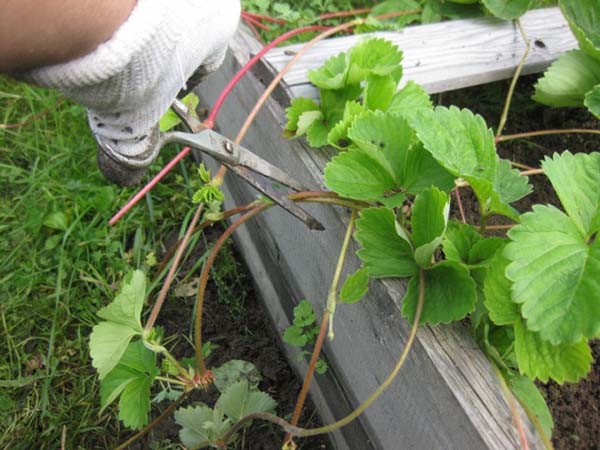
Advice! It is in the first year after fruiting (in the second year of the life of the outlet after overwintering) that take a mustache for breeding, since such a dependence is manifested - the older the bush, the less its potential for reproduction and the weaker the whiskers it will give.
Often the mustache is regularly removed as it grows... But it is optimal to do this before flowering, after fruiting and harvesting, as well as at the end of the summer season. In fact, they are very convenient to clean up the next time you loosen or weed the beds.
Note! Removing the whiskers also further stimulates the formation of future strawberry flower buds.
Video: how and when to remove a mustache from strawberry bushes
Fertilizing strawberries after fruiting
After pruning the strawberry bush, it is advisable to carry out enhanced feeding of the weakened plant, since during this period the garden strawberries are under severe stress and you need to help form its new leaf apparatus.
As a rule, immediately after trimming the leaves, it is recommended to give nitrogen fertilizer, and after a few days (7-10) or closer to autumn - potassium-phosphorus fertilizer.
By the way! More details about autumn feeding strawberries after fruiting you can find in this material.
Strawberry bushes can be shed as nitrogen fertilization mullein solutiondiluted 1 to 10, or bird (chicken) droppings, which should be insisted during the day, while the concentration should be half as much - 1 to 20. Still perfect green manure (3-4 days infusion of herbs, the best thing nettle).
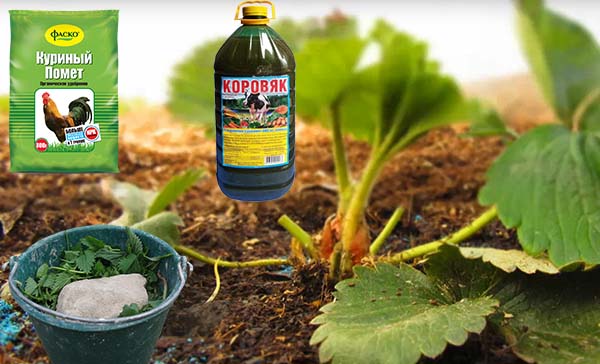
Video: feeding strawberries after harvest
After that (best after a few 7-10 days, although it is possible at the end of summer), it is imperative to give the plant potassium, for example, powder the beds wood ash (or make an infusion or solution), spill with a solution of potassium sulfate (potassium sulfate).
It is also highly desirable to use phosphorus (e.g. superphosphate).
Note! You need to feed only on damp ground and under a bush (without getting on the leaves), therefore, before feeding, be sure to water the strawberries with plain water, or feed after rain.
However, as an option, you can feed the plant immediately after pruning the strawberry bushes (and then again after 7-10 days) fast dissolving complex fertilizer with microelements (such as Crystalon, Master, Plantafol, Kemira), in which equal amount of macronutrients (e.g. 15:15:15 or 18:18:18).
Important! If, after abundant dressing, small flowers began to appear on the bushes, they must be promptly removed, because they will only weaken the plant, and there will be no sense from them.
Post-harvest strawberry treatment for diseases and pests
Or immediately after feeding, or already in second half of August worth doing processing strawberries from diseases and pests.
- From pests, especially against tick, it is best to use - Fitoverm (Aktofit), Bitoxibacillin, Vertimek, Masai.
- From strawberry diseases, especially against brown spot, - Horus (from all spots), Topaz (from powdery mildew), Fitosporin.
By the way! In general, you can make a tank mixture (from 2-3 selected agents) by first dissolving each drug in water separately (according to the instructions), and then pour the resulting solutions into a common container (sprayer).
Remember! If, after mixing the preparations, no sediment falls out, then they can be used in the tank mixture.
Itself processing it is desirable to conduct in calm weather, while carefully you need to spray not only the bushes themselves, but also mulch (if your bushes are mulched). It is advisable to repeat after 2 weeks.
However, if strawberry in this season was very strongly affected by diseases and peststhen it is recommended remove all old mulch, and then carefully treated against diseases and pests.

A folk remedy for treating strawberry bushes from diseases is the use brilliant greendiluted in water in a proportion of 4-5 drops per 1 liter of water. According to some summer residents, brilliant greenIs an excellent antiseptic that helps in the fight against gray mold, powdery mildew and other diseases.
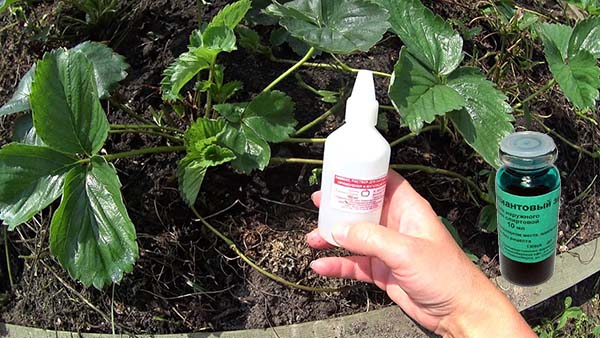
Features of caring for remontant strawberries
Repaired strawberries are able to bear fruit all summer long (hence its name), therefore traditional summer pruning for remontant shrubs is not done... Pruning the leaves completely or even partially weakens the plant noticeably, even if you feed it well afterwards.

Another thing that is needed periodically examine the bushes for diseased and dry leaves, in other words, you need do selective cropping, including after each fruiting and harvesting of strawberry berries.
But as for mustachethen their should still be cutunless, of course, you need them for reproduction.
Video: features of caring for remontant strawberries
Note! Additionally about the autumn preparation of strawberries for winter read in this material.
Thus, if you properly care for strawberries in the summer, following all the tips and tricks, namely, correctly prune the bushes after fruiting and harvesting, and also give a good feeding, treat diseases and pests, then next year you will definitely be wait for a bountiful harvest of tasty and ripe berries.
Video: caring for strawberries after fruiting from A to Z

